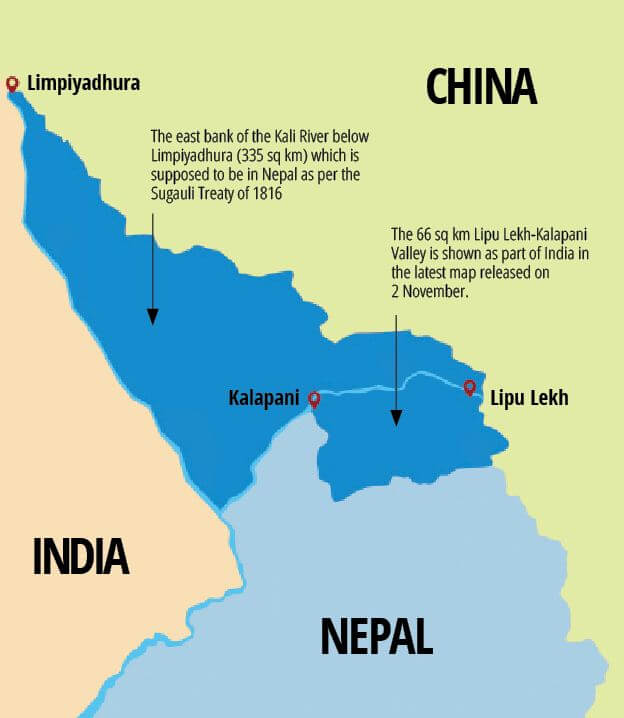TERRITORIALISM
The dispute over the tri-junction of India, China and Nepal on the remotest northwestern tip of the country is the latest strain on bilateral relations.
The Sugauli Treaty of 1816 between the East India Company and the defeated Gorkhalis clearly stated that the main channel of the Mahakali River would form a shrunken Nepal’s western border with British India. But the Survey of India maps of 1850 and 1856 slyly tucked the area back into Garhwal.
Successive rulers in faraway Kathmandu were either unaware or did not care that the boundary had been moved. After the Chinese annexation of Tibet in the 1950s, Nepal allowed India to put up 17 military checkpoints along its northern border. China and India fought a fierce Himalayan war in 1962 during which the Indian military set a base on the strategic Lipu Lekh Valley. That base is still there.
In 1969, Prime Minister Kirti Nidhi Bista got Delhi to remove all its checkpoints on the Nepal-China border, except the one in Kalapani. Was Lipu Lekh a quid pro quo for the removal of the other bases? Did King Mahendra sacrifice the region in return for Indian support for his takeover? Historians are divided.
Whatever the case, the elected rulers of Nepal after 1990 used anti-Indian nationalism for political benefit, but did little to press Nepal’s legitimate claim over the territory. K P Oli, who now heads the united NCP in government, was one of the most vocal in Parliament demanding that India return the area. Current Tourism Minister Yogesh Bhattrarai even led a student group to Kalapani to raise the Nepali flag in the tract occupied by India.

Many field reports from the area have just gathered dust in Singha Darbar. No action was ever taken, except when it was politically expedient to raise an anti-Indian drum beat. Nepal’s own official map in 1975 showed Lipu Khola as the boundary between Nepal and India, and not the Mahakali River. Ultra-nationalists cry themselves hoarse about ‘big bully’ India, but why would a neighbour respect your boundary if you yourself do not really care where it is?
New Delhi has not really been bothered about winning the hearts and minds of Nepalis, either. It believes in carrying the big stick and showing who’s boss. And all this is convenient for Nepal’s India-bashing pseudo-nationalists who have a handy excuse to take to the streets every time the border dispute flares up.
For Prime Minister Oli the brouhaha could not have been better timed. It has allowed him to distract public attention away from his administration’s non-performance, and once more drape himself in the flag. But what good is it to work ourselves into a frenzy of territorialism over this tiny strip of land when our rulers do not seem to care what happens to the rest of the country over which they enjoy full sovereignty?
This is also not one where Nepal can play India off against China. In fact, Beijing seems to be on the same page as New Delhi on the issue. As far back as 1954, India and China agreed to allow Indian pilgrims to use Lipu Lekh Pass on their holy trek to Lake Mansarovar. Lipu Lekh was discussed during visits by Indian External Affairs Minister Jaswant Singh to Beijing in 1999, by Chinese Premier Wen Jiaobao to Delhi in 2005, and by Chinese President Xi Jinping in India in 2014. A joint communiqué between Indian Prime Minister Narendra Modi and President Xi in 2015 in Beijing listed Lipu Lekh as one of the Sino-Indian border passes through which the two countries agreed to conduct trade.

One of the few instances in Nepali history when anti-Chinese protests broke out in the streets of Kathmandu was four years ago after that India-China joint communiqué on Lipu Lekh. Yet, Nepal’s governments since then did not dare broach the subject with the Chinese, it was not even raised last month during President Xi’s state visit to Kathmandu.
Nepal cannot go to war with India over this. (For one thing, our men are enlisted in their army.) How about first revising our own official map, and take up the matter at the highest level in every future bilateral? And they may as well also talk about disputes along the Tarai caused by rivers changing course, and border pillars mysteriously moving under cover of darkness.
The time is right for dialogue: there is a government in Kathmandu with a solid two-thirds majority, we have rare all-party unity over the matter, and Nepal’s international stature is higher than it has been in a while.




